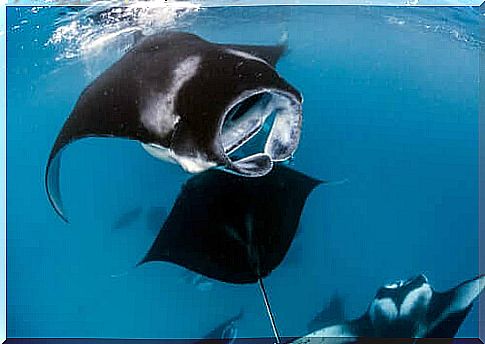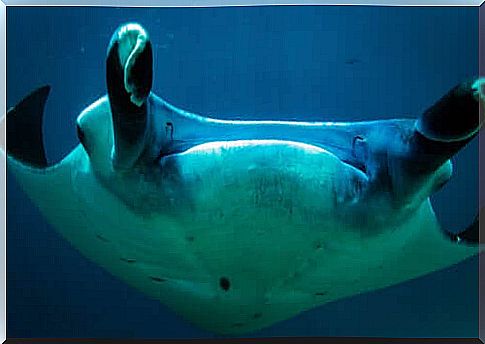The Stingray: The Mysterious Beauty Of The Sea

The stingray is a creature that, due to its appearance, is considered a symbol of marine elegance. Throughout history, this creature has been feared because of the resemblance of its cephalic fins to “demon horns.” Also, there is the fact that the shape of his body resembled a cloak.
However, these giants pose no threat because they feed on plankton and are peaceful creatures. Its grace evokes in us virtuoso dancers who perform an underwater ballet. They fly across the sea performing incredible pirouettes, somersaults and stunts out of the water.
This fish is known by many names around the world. In Brazil, this animal is also popularly called “ray”. In this article, you will get to know the amazing characteristics of this fish.
The classification of stingrays
The stingray belongs to the class of cartilaginous fish or chondrocytes, characterized by having a skeleton entirely composed of cartilaginous tissue. In fact, this group encompasses different species of sharks and stingrays.
Cartilaginous fish are characterized by not having a swim bladder or lungs. Breathing takes place through five to seven pairs of gills open to the outside through gills.
This group of fish does not have an operculum, the bony fin that covers and protects the gills of bony fish. Therefore, they do not have this mechanism to control the entry and exit of water through the gills.

For this reason, cartilaginous fish must remain in continuous motion to force water into the gills. This means that the stingray is an animal that never stops swimming from birth to death.
Cartilaginous fish — elasmobranchs — are very old and have existed for at least 400 million years.
What characterizes the stingray?
The stingrays and blankets expanded the pectoral fins in the form of wings. In swimming, they flap their fins in a wavy motion, analogous to birds in flight.
They have the gills on the ventral part. The heads of both species are broad, with eyes on either side and long mouths in front. In the mouth, there are several rows of small teeth that are not used for chewing but are used so that the males can hold the female during mating.

Above the mouth, there are two cephalic structures, which prolong and guide the flow of water to the mouth. These structures optimize the feeding process that the stingray performs by filtering the water to ingest marine plankton. In fact, they are major plankton consumers.
Both species have a whip-shaped tail. However, unlike other species of the same order, the two species of stingrays do not have a venomous sting in their tail.
This marine animal is very intelligent: experts recognize that it has the biggest brain among all fish. They have recently been shown to have the most developed cognitive abilities among fish.
stingray habitat
They live in tropical waters around the world. Curiously, manta rays visit “maintenance stations” on the reefs, where they are cleaned by opportunistic fish or remoras.
How big is the stingray?
The large, flat body has a center that is called the “disk”. In the case of the reef stingray, the disc width varies between 3 and 3.5 meters. In the giant ray, the disc can measure up to nine meters in width and weigh up to 1350 kg.
Generally, specimens of four and a half meters are found. Also, a stingray can live for around 25 years.

Skin Sensitivity
The stingray’s body is covered by a protective mucous membrane. This mucus has two basic functions: it acts as a barrier against infection and it reduces friction to make it easier to move when swimming.
This membrane can be damaged by human contact. So if you are near a stingray, avoid touching it.
An extraordinary characteristic of manta rays—and of all cartilaginous fishes—is that they have an elaborate system of bubbles in their skin that are sensitive to low-frequency electrical stimuli. These electroreceptors are known as “Lorenzini ampoules”.
Therefore, they are determining factors for orientation towards electric fields, caused by terrestrial geomagnetism and by the tides.
In addition, the electroreceptor system also allows detecting the electromagnetic fields generated by their prey or potential predators and their congeners during social interactions and mating.
Threats to the stingray
These fish were hunted for sport, for their meat, oil or by mistake in commercial fishing tasks. Currently, stingray hunting is limited . Also, in areas such as Hawaii in the United States, it is on the list of protected species.
The protection of the stingray is of economic interest as it attracts a large number of tourists. Without a doubt, this fish adds beauty, diversity and mystery to our world.








